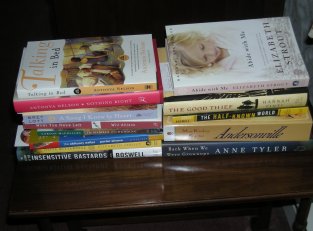. . . when I was in my twenties, I started going to Jahorina in the summer for long reading holidays. . . . In our cabin I could read for eight to ten hours a day, fully in charge of my own time. . . . In the cabin I would enter a kind of hypersensitive trance that allowed me to average four hundred pages a day.
                                  — Aleksandar Hemon, b. 1964
                                       Bosnian-American fiction writer
 The double issue of The New Yorker dated June 8 & 15, 2009, is designated the “Summer Fiction Issue,” and its purchase each year signals the beginning of my summer reading season. The Atlantic publishes its special fiction issue in August. I usually get that sometime during my trip to or from Vermont, when my car is laden with the new titles I’ve acquired at Bread Loaf and my head is crammed with the ideas I’ve brought down from the mountain about how to go forward in my own work.
The double issue of The New Yorker dated June 8 & 15, 2009, is designated the “Summer Fiction Issue,” and its purchase each year signals the beginning of my summer reading season. The Atlantic publishes its special fiction issue in August. I usually get that sometime during my trip to or from Vermont, when my car is laden with the new titles I’ve acquired at Bread Loaf and my head is crammed with the ideas I’ve brought down from the mountain about how to go forward in my own work.
That “summer reading” is different from that done in other seasons comes from the notion that people are more relaxed in the summer, have more free time. I’ve lived my whole life by the academic calendar, in which “a year” is that nine-month stretch between Labor Day and Memorial Day, and “summer” is a free-floating period of rest and recovery from one “year” that morphs into a time of anticipation of and preparation for the next. When I was a teacher I read for instruction, I read to fulfill assignments and prepare lessons, I read to learn more about the authors I was teaching, I read the papers my students wrote in response to my instruction. In the summer, I read for pleasure, although there was little I read that did not have some bearing on my role as a teacher of literature and how to respond to it.
I’m not sure how to characterize my reading now. I read to learn, I read to respond, I read to study craft, I read to remember. It seems I write for those same reasons. And I do it because I don’t know who I am or what I am if I don’t.
Above is a picture of the stack of ten books I pulled on May 24, the day I stopped moping about my Bread Loaf rejection and got back to work. Teacher Heather Sellers advises reading one hundred books like the one you want to write. It was then about ten weeks until I would leave for Vermont. Starting with ten books seemed reasonable.
I’ve done this before — assembled a collection of titles with the intention of reading steadily through the stack until I’m finished. And each time I do that, I discover anew that I don’t have that kind of focus. I’m not like Aleksandar Hemon, able to make of a book “a vast, intricate space in my head where I stayed even when eating, hiking, or sleeping.” In his New Yorker essay remembering his summers of reading at his parents’ cabin near Sarajevo, he reports that it took him less than a week to read War and Peace. I’m learning to make more quickly and more deliberately what I call the “fall into fiction,” that state of mind in both the reading and the writing of it when I’m not reading or writing about the characters and their lives, I am those characters, and their lives are mine.
The fall itself is getting easier. The duration of my stay remains a problem. I read thirty pages an hour, generally, write even more slowly. Though I am indeed fully in charge of my own time, it has taken me four weeks to read the book on the top of the right-hand stack, Elizabeth Strout’s Abide With Me. This morning I put it in a box destined for the public library’s annual used book collection, and began Will Allison’s What You Have Left. I think it’s the one under the Antonya Nelson book in the left-hand stack.
I have seven weeks until I leave for Vermont. I don’t know how much that stack will be reduced. From conversations with my writer friends and ideas that come from some of my more casual reading, I’ve already added to it since I took the picture. I’m in an online workshop now and have three stories a week to read for that, plus two manuscripts for another literary gallivant to New Jersey in July, along with the work I exchange with two writing friends. And of course Andersonville, in its imposing 750 pages, which I will read because I love its author so much, might take me the rest of my life.
Â
Love it? Hate it? Just want to say hi?
To comment or to be included on the notify list, e-mail me:
margaretdeangelis [at] gmail [dot] com (replace the bracketed parts with @ and a period) OR
Follow me on Twitter: http://twitter.com/silkentent